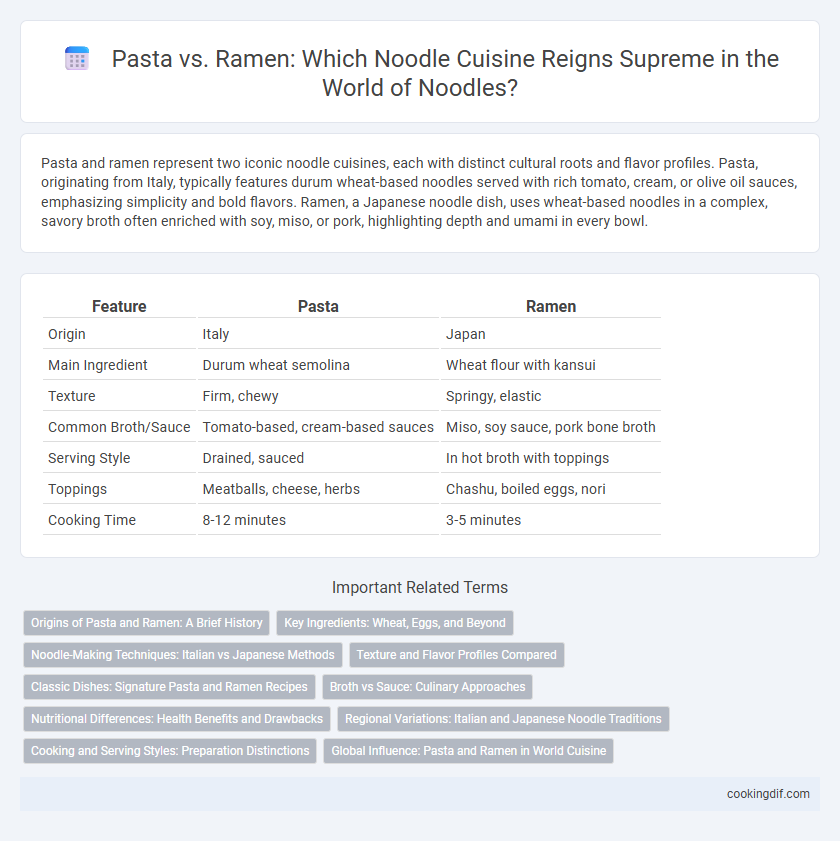Pasta and ramen represent two iconic noodle cuisines, each with distinct cultural roots and flavor profiles. Pasta, originating from Italy, typically features durum wheat-based noodles served with rich tomato, cream, or olive oil sauces, emphasizing simplicity and bold flavors. Ramen, a Japanese noodle dish, uses wheat-based noodles in a complex, savory broth often enriched with soy, miso, or pork, highlighting depth and umami in every bowl.
Table of Comparison
| Feature | Pasta | Ramen |
|---|---|---|
| Origin | Italy | Japan |
| Main Ingredient | Durum wheat semolina | Wheat flour with kansui |
| Texture | Firm, chewy | Springy, elastic |
| Common Broth/Sauce | Tomato-based, cream-based sauces | Miso, soy sauce, pork bone broth |
| Serving Style | Drained, sauced | In hot broth with toppings |
| Toppings | Meatballs, cheese, herbs | Chashu, boiled eggs, nori |
| Cooking Time | 8-12 minutes | 3-5 minutes |
Origins of Pasta and Ramen: A Brief History
Pasta originated in Italy, dating back to the Etruscans around 400 BCE, with durum wheat semolina as its primary ingredient, contributing to its firm texture. Ramen, a traditional Japanese noodle dish, evolved from Chinese wheat noodles introduced to Japan in the late 19th century, combining Chinese culinary influences with Japanese flavors. Both pasta and ramen reflect their distinct cultural heritages through unique preparation methods and ingredient choices, shaping their roles in global noodle cuisine.
Key Ingredients: Wheat, Eggs, and Beyond
Pasta primarily consists of wheat flour and eggs, creating a firm texture ideal for Italian dishes, while ramen noodles rely on wheat flour combined with kansui, an alkaline mineral water that imparts a distinctive chewiness and yellow hue. Egg is a key ingredient in many pasta varieties, lending richness and elasticity, whereas traditional ramen rarely contains eggs within the noodle dough but often incorporates boiled eggs as a topping. Exploring noodle cuisines reveals that wheat's versatile role adapts significantly depending on additional ingredients, shaping regional textures and flavors in pasta and ramen.
Noodle-Making Techniques: Italian vs Japanese Methods
Italian pasta-making techniques emphasize the use of durum wheat semolina and involve rolling and cutting dough into various shapes like spaghetti or fettuccine, often dried for preservation. Japanese ramen-making centers on alkaline water (kansui) in the dough, producing a firm texture and distinctive yellow color, with hand-pulling or machine-pressing methods to create fresh, springy noodles. The contrast in ingredients and craftsmanship highlights the cultural significance and unique textures integral to each cuisine's noodle dishes.
Texture and Flavor Profiles Compared
Pasta typically offers a firm, al dente texture with a mild, slightly wheaty flavor that acts as a versatile base for rich, tomato-based or creamy sauces. Ramen noodles have a chewy, springy bite and a savory, slightly salty taste, enhanced by umami-rich broths like miso, soy, or tonkotsu. The contrast in texture and flavor profiles highlights pasta's adaptability to diverse Western sauces, while ramen emphasizes broth harmony and a satisfying mouthfeel unique to East Asian cuisine.
Classic Dishes: Signature Pasta and Ramen Recipes
Classic pasta dishes like Spaghetti Carbonara and Fettuccine Alfredo showcase Italian culinary tradition with rich, creamy sauces and al dente textures. Traditional ramen recipes, such as Tonkotsu and Shoyu, feature deeply flavored broths and tender noodles, emphasizing umami and savory toppings like chashu and soft-boiled eggs. Both cuisines highlight regional ingredients and cooking techniques that define the essence of noodle craftsmanship in pasta and ramen.
Broth vs Sauce: Culinary Approaches
Pasta dishes traditionally emphasize rich, often creamy or tomato-based sauces that coat the noodles, creating a harmonious blend of textures and flavors. Ramen centers on complex broths, such as tonkotsu or miso, which serve as the soup base, infusing the noodles with deep umami and aromatic qualities. The culinary approach in pasta relies on sauce adherence for flavor delivery, while ramen uses broth immersion to create a layered, warming experience.
Nutritional Differences: Health Benefits and Drawbacks
Pasta typically provides higher amounts of protein and iron due to its wheat base, while ramen often contains more sodium and preservatives, which can impact cardiovascular health. Ramen's broth can offer additional nutrients like collagen and minerals when made from bone stock, but instant varieties are often high in unhealthy fats and artificial additives. Choosing whole grain pasta enhances fiber intake and supports digestive health, whereas fresh ramen noodles made from wheat flour can deliver quicker energy but may lack these dietary fibers.
Regional Variations: Italian and Japanese Noodle Traditions
Italian pasta and Japanese ramen showcase distinct regional noodle variations rooted in their unique culinary traditions. Pasta, often made from durum wheat, features varieties such as spaghetti, penne, and fettuccine, emphasizing simple sauces like marinara or Alfredo. Ramen, typically made from wheat flour with kansui, highlights rich, complex broths like shoyu, miso, or tonkotsu, reflecting Japanese regional diversity in noodle dishes.
Cooking and Serving Styles: Preparation Distinctions
Pasta typically involves boiling durum wheat-based dough until al dente and serving with sauces like marinara, Alfredo, or pesto, emphasizing a firm texture and rich, often creamy or tomato-based flavors. Ramen preparation includes cooking wheat noodles in savory broth, often pork or miso-based, combined with toppings such as sliced pork, soft-boiled eggs, and seaweed, highlighting a balance of umami and broth depth. Serving styles diverge with pasta presented primarily as a dry or sauced dish, while ramen is served as a soupy noodle bowl, showcasing the integral role of broth in flavor delivery.
Global Influence: Pasta and Ramen in World Cuisine
Pasta and ramen both serve as iconic staples in global noodle cuisine, each shaped by distinct cultural heritages and culinary techniques. Pasta, originating from Italy, has become integral in Western and fusion dishes worldwide, highlighting its versatility and adaptability across diverse sauces and preparations. Ramen, a Japanese noodle dish with Chinese origins, commands international acclaim through rich broths and varied toppings, influencing contemporary culinary trends and inspiring ramen shops in major cities around the globe.
pasta vs ramen for noodle cuisine Infographic

 cookingdif.com
cookingdif.com